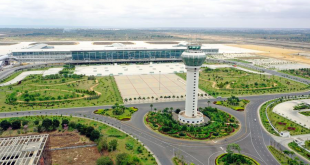In my previous article, I gave enough examples to illustrate that colonial infrastructures were not mean to serve African interests. However, we cannot continue to cry over spilled milk. Africa on the average is 60 years independent and needs therefore to link infrastructure to serve African interests. There is also need to deliberately choose allies and partners that contribute to this cause. Most importantly, political will by African leaders will be paramount in developing African infrastructure. The NEPAD, African Union and African Development Bank (AfDB) Programme for Infrastructure Development in Africa (PIDA) are a case in point. The 30-year strategy was designed, focusing on regional trans-boundary projects.
According to former Prime Minister of Niger Dr. Ibrahim Mayaki the chief executive officer of NEPAD, PIDA was designed from the bottom up which is positive. He gives the 4,500-kilometres highway from Algiers in Algeria to Lagos in Nigeria, as such an example of great Intra Africa partnership on infrastructure development emphasizing the already mentioned political will concluding that it would not have been possible without the political and technical support of each of the affected countries.
Another excellent example, is the Kenya Standard Gauge Railway system that will connect Kenyan cities, and link the country to the neighboring country of Uganda, and through Uganda, to South Sudan, the Democratic Republic of the Congo, Rwanda, and Burundi. The Project was adopted in 2014, by the East Africa Presidents who launched a multibillion SGR project meant to modernize the traditional railway transport system to boost economic growth by facilitating a faster movement of goods across borders. The Kenyan standard gauge railway, constructed by the China Road and Bridge Corporation (CRBC) and financed by the Chinese government, has been partly implemented.
The Nairobi-Mombasa leg, apparently bogged by political squabbles, and corruption have delayed further implementation in the region. No matter how well intentioned Rwanda, Burundi and DR Congo may be, they cannot implement their rail section unless, Uganda completes its part. This is a total opposite of the good will the Algeria- Nigeria road implementation earlier quoted by the NEPAD Chief executive. There have also been allegations of private sector interests particularly transporters-owners of Trucks who stand to lose business when the railway is fully implemented.
Although the first segment, between Mombasa and Nairobi, opened passenger rail service in June 2017, and freight rail service in January 2018, the railway is said to be making losses, partly because the amount of cargo that would have gone through to Uganda, Rwanda, Burundi, and DR Congo hinterland is not yet operational. Other segments are under construction or planned. The new Standard Gauge Railway (SGR), is intended to replace the old, inefficient meter-gauge railway system at an ambitious costs of US$3.6 billion.
Optimists however, believe that this is a temporally setback, and that in the long run national interests will reign over politics and lobbyists. Quoting the Burundi, Democratic Republic of Congo and Rwanda, recent revival of joint construction of the Ruzizi 3 hydroelectric power station aimed at boosting the electricity production for these three countries that had been on hold for some years.
The power project will be the first privately funded project in sub-Saharan Africa that will use a common regional resource to generate energy that will be shared equally between three countries.
The Ruzizi 3 hydropower plant will be located in Bukavu in South Kivu province in the Democratic Republic of the Congo. Ruzizi is the river through which Lake Kivu flows into Lake Tanganyika.
Construction of the projects dates back to 1992. However, due to various upheavals that the three countries went through, the project was never realized. The Ruzizi 3 could produce up to 200 MW when additional studies are finalized. Its initial capacity is estimated at 144 MW.
Construction and operation of Ruzizi 3 will be carried out by the Consortium Industrial Promotion Services (IPS) and SN Power. The Ruzizi III hydroelectric project is undergoing a new development.
The ministers from the three countries selected two companies to develop the Ruzizi III hydroelectric project as part of a public-private partnership (PPP). It is a consortium composed of the Norwegian company SN Power, already known in Africa, notably for its participation in the Volobe hydroelectric project (120 MW) in Madagascar and Industrial Promotion Services (IPS), the industrial branch of the Aga Khan Fund for Economic Development (AKFED).
These companies also signed public-private partnership agreements with the three countries. Upon completion, the power project, electricity generated from it will cost between US $11 and US $13 per kWh.
Several joint projects do exit in different parts of Africa. Indeed such regional projects do not only alleviate poverty, but also contribute to peace and security. It is my view for example, that Egypt and the Sudan under the Africa Union led negotiations, could approach Ethiopia and invest in the ambitious 5 billion US dollars Grand Ethiopian Renaissance Dam (GERD), instead of listening to former President Trump’s call for ‘GERD bombardment’.
The GERD is financed by Ethiopia with support from China. Africa’s need to take infrastructure with the seriousness it deserves has been well articulated by one of Africa’s leading infrastructure partner in the following words, “Inadequate infrastructure is believed to be the biggest bottleneck to Africa’s development”
Mweusi Karake is a veteran journalist and former head of Public Relations/Corporate Communication at the Common Market for Eastern and Southern Africa (COMESA).For comments or opinion email us on; info@africachinareview.com
 Africa -China Review Africa -China Cooperation and Transformation
Africa -China Review Africa -China Cooperation and Transformation
